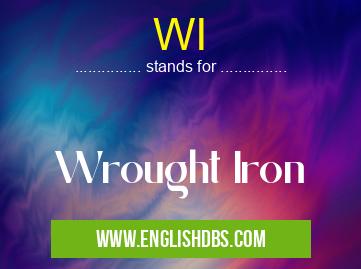What does WI mean in MANUFACTURING
WI stands for Wrought Iron, a type of iron with a unique composition and properties that make it suitable for various applications in construction, engineering, and decorative arts. Wrought iron is known for its strength, durability, and malleability, making it a popular choice for intricate designs and artistic creations.

WI meaning in Manufacturing in Miscellaneous
WI mostly used in an acronym Manufacturing in Category Miscellaneous that means Wrought Iron
Shorthand: WI,
Full Form: Wrought Iron
For more information of "Wrought Iron", see the section below.
Characteristics of Wrought Iron
- High Strength: Wrought iron has a high tensile strength, making it resistant to deformation under stress.
- Malleability: Wrought iron is highly malleable, allowing it to be shaped and worked into intricate designs.
- Corrosion Resistance: Wrought iron has good corrosion resistance, especially when protected by a coating of paint or other protective measures.
- Low Carbon Content: Compared to other types of iron, wrought iron has a relatively low carbon content, typically between 0.02% and 0.15%.
- Grain Structure: Wrought iron has a fibrous grain structure, which contributes to its strength and durability.
Applications of Wrought Iron
Wrought iron is used in a wide range of applications, including:
- Construction: Wrought iron is used in structural components, such as beams, columns, and trusses.
- Decorative Arts: Wrought iron is often used in decorative elements, such as railings, gates, fences, and furniture.
- Engineering: Wrought iron is used in various engineering applications, such as machine parts, gears, and chains.
- Automotive: Wrought iron is used in some automotive components, such as suspension systems and exhaust systems.
Advantages of Wrought Iron
- Strength and Durability: Wrought iron offers excellent strength and durability, making it suitable for load-bearing applications.
- Artistic Value: Wrought iron's malleability allows for the creation of intricate and visually appealing designs.
- Versatility: Wrought iron can be used in a wide range of applications, from structural components to decorative elements.
- Sustainability: Wrought iron is a sustainable material that can be recycled and reused.
Essential Questions and Answers on Wrought Iron in "MISCELLANEOUS»MANUFACTURING"
What is Wrought Iron?
Wrought iron is a type of iron alloy with a low carbon content, typically less than 0.08%. It is produced by hammering or rolling wrought iron blooms to remove impurities and refine the grain structure.
How is Wrought Iron Different from Other Types of Iron?
Wrought iron differs from cast iron and steel due to its lower carbon content. This results in a softer, more malleable material that is easily worked and shaped. It also has a higher melting point than cast iron and a lower tensile strength than steel.
What Are the Advantages of Wrought Iron?
Wrought iron offers several advantages, including:
- Malleability: Its low carbon content makes it highly malleable, allowing for intricate forging and shaping.
- Durability: Wrought iron is resistant to corrosion and wear due to its fibrous structure.
- Longevity: With proper maintenance, wrought iron can last for centuries.
Where is Wrought Iron Used?
Wrought iron is used in various applications, such as:
- Ornamental work: Gates, railings, balconies, and decorative elements.
- Architectural elements: Columns, beams, and other structural components.
- Tools and equipment: Hammers, axes, and other hand tools.
How is Wrought Iron Maintained?
Regular maintenance is crucial for the longevity of wrought iron. This includes:
- Cleaning: Remove dirt and debris with a soft brush or cloth.
- Rust prevention: Apply protective coatings to prevent rust formation.
- Repainting: Paint or touch up wrought iron surfaces as needed to maintain its appearance.
Final Words: WI, or Wrought Iron, is a versatile and valuable material with a unique combination of properties that make it suitable for a variety of applications. Its strength, durability, malleability, and corrosion resistance make it a popular choice in construction, engineering, and decorative arts. Wrought iron continues to be an important material in various industries, offering both functional and aesthetic value.
